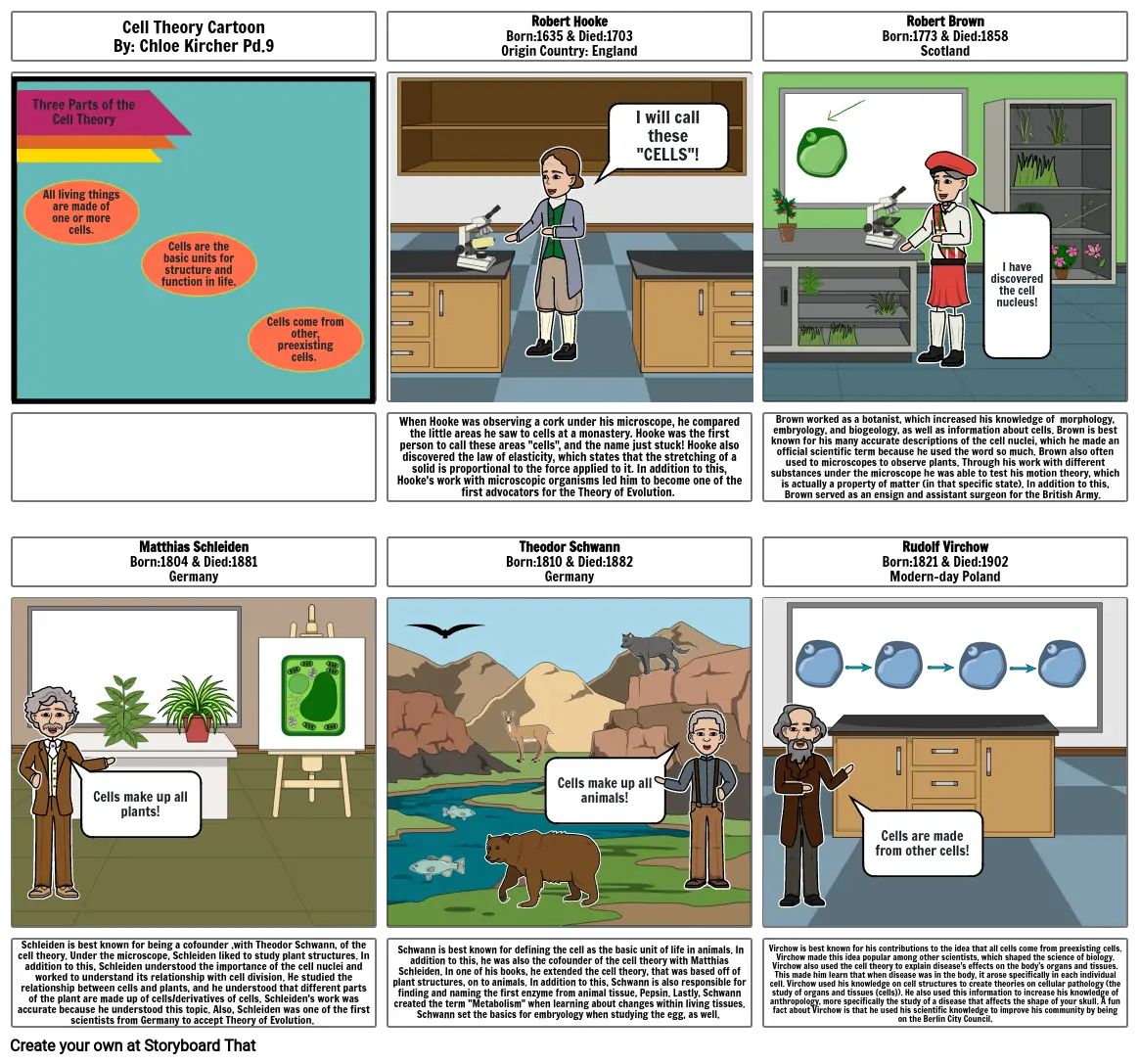CK- Cell Theory Cartoon

Tekst Storyboardowy
- Cell Theory CartoonBy: Chloe Kircher Pd.9
- Three Parts of the Cell Theory
- All living things are made of one or more cells.
- Cells are the basic units for structure and function in life.
- Cells come from other, preexisting cells.
- Robert HookeBorn:1635 & Died:1703Origin Country: England
- I will call these "CELLS"!
- Robert BrownBorn:1773 & Died:1858Scotland
- I have discovered the cell nucleus!
- Matthias SchleidenBorn:1804 & Died:1881Germany
- When Hooke was observing a cork under his microscope, he compared the little areas he saw to cells at a monastery. Hooke was the first person to call these areas "cells", and the name just stuck! Hooke also discovered the law of elasticity, which states that the stretching of a solid is proportional to the force applied to it. In addition to this, Hooke's work with microscopic organisms led him to become one of the first advocators for the Theory of Evolution.
- Theodor SchwannBorn:1810 & Died:1882Germany
- Brown worked as a botanist, which increased his knowledge of morphology, embryology, and biogeology, as well as information about cells. Brown is best known for his many accurate descriptions of the cell nuclei, which he made an official scientific term because he used the word so much. Brown also often used to microscopes to observe plants. Through his work with different substances under the microscope he was able to test his motion theory, which is actually a property of matter (in that specific state). In addition to this, Brown served as an ensign and assistant surgeon for the British Army.
- Rudolf VirchowBorn:1821 & Died:1902Modern-day Poland
- Schleiden is best known for being a cofounder ,with Theodor Schwann, of the cell theory. Under the microscope, Schleiden liked to study plant structures. In addition to this, Schleiden understood the importance of the cell nuclei and worked to understand its relationship with cell division. He studied the relationship between cells and plants, and he understood that different parts of the plant are made up of cells/derivatives of cells. Schleiden's work was accurate because he understood this topic. Also, Schleiden was one of the first scientists from Germany to accept Theory of Evolution.
- Cells make up all plants!
- Schwann is best known for defining the cell as the basic unit of life in animals. In addition to this, he was also the cofounder of the cell theory with Matthias Schleiden. In one of his books, he extended the cell theory, that was based off of plant structures, on to animals. In addition to this, Schwann is also responsible for finding and naming the first enzyme from animal tissue, Pepsin. Lastly, Schwann created the term "Metabolism" when learning about changes within living tissues. Schwann set the basics for embryology when studying the egg, as well.
- Cells make up all animals!
- Virchow is best known for his contributions to the idea that all cells come from preexisting cells. Virchow made this idea popular among other scientists, which shaped the science of biology. Virchow also used the cell theory to explain disease’s effects on the body's organs and tissues. This made him learn that when disease was in the body, it arose specifically in each individual cell. Virchow used his knowledge on cell structures to create theories on cellular pathology (the study of organs and tissues {cells}). He also used this information to increase his knowledge of anthropology, more specifically the study of a disease that affects the shape of your skull. A fun fact about Virchow is that he used his scientific knowledge to improve his community by being on the Berlin City Council.
- Cells are made from other cells!
Utworzono ponad 30 milionów scenorysów

